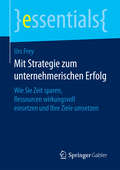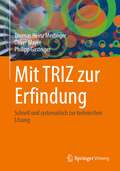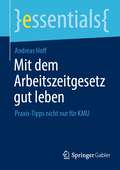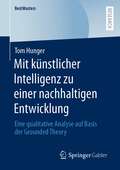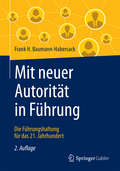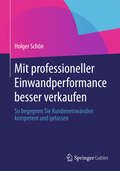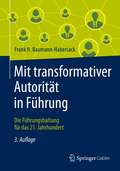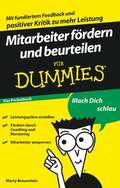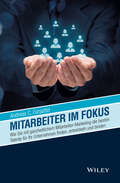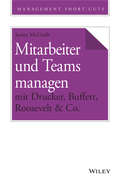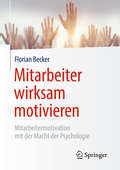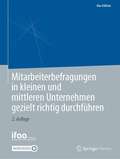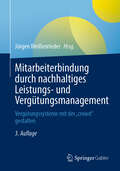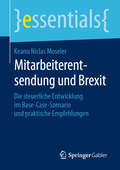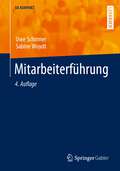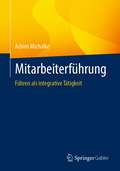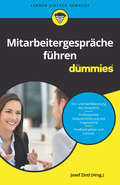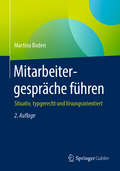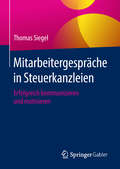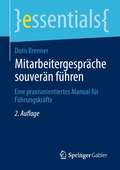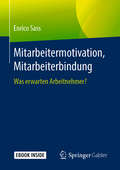- Table View
- List View
Mit Strategie zum unternehmerischen Erfolg: Wie Sie Zeit sparen, Ressourcen wirkungsvoll einsetzen und Ihre Ziele umsetzen (essentials)
by Urs FreyUrs Frey zeigt in diesem Buch, dass Sie als Unternehmer mit Strategie weiterkommen. Diese wird Ihnen helfen, Zeit zu sparen, Ihre Ressourcen wirkungsvoll einzusetzen, Ihre Ziele zu erreichen und Ihrer Konkurrenz eine Nasenl#65533;nge voraus zu sein! Daf#65533;r ben#65533;tigen Sie weder viel Zeit noch strategisches Theoriewissen oder einen teuren Strategieexperten. Mit einer guten Portion frohen Mutes, einem produktiven Abend und den klaren Arbeitsanweisungen in diesem Buch haben Sie alles, was Sie f#65533;r Ihre Strategie ben#65533;tigen.
Mit TRIZ zur Erfindung: Schnell und systematisch zur technischen Lösung
by Thomas Heinz Meitinger Oliver Mayer Philipp GasteigerZur Lösung eines technischen Problems benötigt ein Erfinder technisches Know-How. Allerdings reicht technisches Know-How allein oft nicht aus, um eine technische Aufgabe zu bewältigen. Erst die Kombination von technischem Know-How mit einer systematischen und zielgerichteten Methodik der Problemlösung kann zur Lösung des technischen Problems führen. Dieses Fachbuch präsentiert den Werkzeugkasten des TRIZ-Systems zur Lösung technischer Aufgaben, wobei ein Schwerpunkt auf die grundlegenden physikalischen Effekte und die TRIZ-Innovationsprinzipien gelegt wird. Außerdem werden das SIT (Structurized Inventive Thinking), das Stoff-Feld-Modell und die Wege zur Idealität vorgestellt.
Mit dem Arbeitszeitgesetz gut leben: Praxis-Tipps nicht nur für KMU (essentials)
by Andreas HoffDas deutsche Arbeitszeitgesetz (ArbZG) ist von wachsender Bedeutung: Weil immer weniger Betriebe tarifgebunden sind und Betriebsräte haben, gibt es für die betrieblichen Arbeitszeitsysteme immer öfter nur den arbeitszeitgesetzlichen Rahmen. Dieses Essential unterstützt alle, die für die Gestaltung und Praktizierung von betrieblichen Arbeitszeitsystemen verantwortlich sind und/oder diese steuern. Kompakt und fundiert soll es dabei helfen, mit dem ArbZG gut zu leben: Erstens im Sinne einer friedlichen Koexistenz, in der Sie Gesetzesverstöße vermeiden, die zu Geldbußen und im Extrem sogar zu Freiheitsstrafen führen können und auch zum Ausschluss von öffentlichen Aufträgen. Zweitens durch Aufzeigen der vielen Möglichkeiten, die dieses sehr flexible Gesetz bietet, das zugleich – drittens – gesundheitsgerechtes Arbeiten fördert. Mit detaillierten Praxis-Tipps zu den wichtigsten ArbZG-Bestimmungen in allen Kapiteln.
Mit künstlicher Intelligenz zu einer nachhaltigen Entwicklung: Eine qualitative Analyse auf Basis der Grounded Theory (BestMasters)
by Tom HungerDieses Buch befasst sich mit den Einsatzmöglichkeiten der künstlichen Intelligenz (KI) für eine nachhaltige Entwicklung. Im Fokus der Arbeit stehen die einzelnen Formen der KI und wie diese zur Erreichung der Sustainable Development Goals (SDGs) beitragen könnten. Dies wird anhand von Anwendungsbeispielen verdeutlicht. Darüber hinaus ist es bisher eine der ersten Arbeiten, die den Einsatz der KI sowohl auf die SDGs als auch auf deren Unterziele bezieht. Als Methodik zur Erreichung des Forschungszieles wird eine qualitative Analyse auf Basis der Grounded Theory durchgeführt. Dadurch können annähernd 50 wissenschaftliche Artikel systematisch analysiert werden.
Mit neuer Autorität in Führung
by Frank H. Baumann-Habersack Arist Von SchlippeWas ist das Geheimnis von Autorität – welche Form von Autorität benötigen Führungskräfte künftig? Diese Frage beantwortet Frank H. Baumann-Habersack fundiert, konkret, anschaulich, praxisbezogen. Dem Leser wird deutlich, was sich hinter dem Begriff „Neue Autorität“ verbirgt und warum Chefs, die erfolgreich führen wollen, sie benötigen. Der Autor ermutigt, einen Paradigmenwechsel in der Art des Führens zu vollziehen.Autoritäres Machtgehabe war gestern. Heute bedarf es transparenter, selbstkontrollierter, beharrlicher und vernetzter Führung. Frank H. Baumann-Habersack beschreibt als Pionier, wie Führen mit Neuer Autorität gelingt. Er skizziert die Möglichkeiten, wie der Wandel zu einer zeitgerechten Führungskultur gelingt. Führungskräfte lernen somit, ihre Wirksamkeit zu steigern – zum Wohle des Unternehmens, der Mitarbeiter und ihrer selbst.Mit einem Vorwort von Prof. Dr. Arist von Schlippe, dem Mitbegründer des Konzepts „Neue Autorität" in Deutschland.„Der Vergleich der beiden Arten alter zu neuer Autorität in der Führung ist sehr klar und überzeugend dargestellt.“ Prof. Haim Omer, Begründer des Konzepts „Neue Autorität“„Ein lesenswertes, praxisbezogenes Buch, das einen guten Überblick bietet.“ „Wirtschaft und Weiterbildung“, 3/2016
Mit positiver Führung die Mitarbeiterbindung fördern: Etablierung einer Bindungskultur in hybriden Zeiten
by Michael HüblerEine positive Führung zielt auf die Zufriedenheit und Motivation der Mitarbeiter ab, damit diese langfristig bessere Leistungen erbringen, produktiver sind und das Unternehmen erfolgreicher ist. Eine positiv eingestellte Führungskraft ist sowohl an der Weiterentwicklung der Mitarbeiter als auch am Arbeitsergebnis interessiert. Positive Führungskräfte gestalten folglich Atmosphären, in denen sich sowohl die Teammitglieder individuell als auch erfolgreich zusammenarbeitende Teams weiterentwickeln. Eine Fähigkeit, die in normalen Zeiten zu produktiven Höchstleistungen führt und in Krisenzeiten den Unsicherheiten von Mitarbeitern entgegen wirkt. Es geht dabei darum, auf der Basis einer freundlich-wertschätzenden Stimmung Wachstum zu generieren und auch die Bearbeitung kritischer Themen zu erleichtern. Wenn Sie so wollen, bietet eine Führung auf der Basis der positiven Psychologie einen knallhart bezifferbaren Return of Investment. Konkret werden mit einer positiven Führung die Mitarbeiter ermutigt, eigene Wege zu gehen, beispielsweise im Homeoffice, und dennoch die Bindung zu Führung und Team nicht zu verlieren. Eine positive Führung zielt jedoch auch darauf ab, in der Zusammenarbeit nicht nur Stress zu vermeiden oder Konflikte zu bereinigen, sondern bereits prophylaktisch eine positive Atmosphäre zu kreieren, die auch beispielsweise im Großraumbüro zu kreativen Höchstleistungen anspornt, indem sie die Bindung untereinander fördert. Wenn die Arbeitswelt auf der einen Seite immer technischer wird, brauchen wir auf der anderen Seite eine Führung, die das Menschliche in den Vordergrund stellt und damit die Beziehungen zueinander fördert. Eine praxisnahe und inspirierende Orientierung, nicht nur für Führungskräfte.
Mit professioneller Einwandperformance besser verkaufen: So begegnen Sie Kundeneinwänden kompetent und gelassen
by Holger SchönHolger Schön zeigt, wie Vertriebler professionell mit Kundeneinwänden in Verkaufsgesprächen umgehen können. Der Leser erfährt, wie er seine innere Einstellung gegenüber Kundeneinwänden optimiert und welche Techniken er nutzen kann, um mit mehr Wissens- und Handlungskompetenz auf Einwände des Kunden einzugehen. Somit verlieren Einwände wie "Das ist zu teuer!", "Dafür haben wir keine Zeit!" oder "Darüber will ich noch nachdenken!" ihren Schrecken und werden nicht als Misserfolg, sondern als Vorbote eines Verkaufsabschlusses erlebt. Dadurch ist ein Quantensprung in der Entwicklung der Verkäuferpersönlichkeit möglich. Der Weg zum Verkaufserfolg wird dabei mit Geschichten und Praxisbeispielen untermauert.
Mit transformativer Autorität in Führung: Die Führungshaltung für das 21. Jahrhundert
by Frank H. Baumann-HabersackWas versteckt sich hinter dem Mythos Autorität – welche Form von Autorität benötigen Führungskräfte in Zeiten einer epochalen Transformation? Diese Frage beantwortet Frank H. Baumann-Habersack fundiert, anschaulich und praxisbezogen. Leser*innen erfahren, was sich hinter dem Begriff „Transformative Autorität“ verbirgt und warum Chef*innen, die wirksam führen wollen, sie benötigen. Der Autor ermutigt damit zu einem Paradigmenwechsel in der Haltung des Führens. Autoritäres Machtgehabe war gestern. Heute bedarf es präsenter, transparenter, beharrlicher und vernetzter Führung. Frank H. Baumann-Habersack beschreibt, was Entscheider*innen tun können, um zukünftig wirksam zu führen und wie die Transformation zu einer zukunftsweisenden Führungskultur gelingt. Führungskräfte lernen somit, ihre Wirksamkeit zu steigern – zum Wohle des Unternehmens, der Mitarbeiter*innen und ihrer selbst. Mit einem Vorwort von Prof. Dr. Arist von Schlippe, dem Mitbegründer des Konzepts „Neue Autorität" in Deutschland. „Das in diesem Buch eingeführte Konzept der transformativen Autorität baut folgerichtig auf den Gedanken der Neuen Autorität auf. Es versorgt den Autoritätsbegriff mit einer inhaltlichen Präzisierung, die es leichter machen dürfte, ihn zu akzeptieren, insbesondere wenn es um die Einführung im Organisationskontext geht.“ Prof. Arist von Schlippe „Das Konzept der transformativen Autorität ist eine der anregensten Weiterentwicklungen des Konzepts der neuen Autorität. Es wirkt über die Anwendung der neuen Autorität hinaus in Organisationen. Dadurch, dass es den Fragen zu Führung und Transformation mit ihren dynamischen, zwischenmenschlichen Beziehungen auf den Grund geht. Dieses Buch ist eine höchst erfreuliche Erweiterung der Literatur über die Grenzen, Möglichkeiten und Herausforderungen von Führung in unserer heutigen Welt.“ Prof. Haim Omer
Mitarbeitende inspirieren: Inspiration fördern und im Unternehmen wirkungsvoll vorantreiben (Science meets Practice)
by Thomas Rudolph Kathrin NeumüllerEin dynamisches und disruptives Marktumfeld verlangt von Unternehmen und ihren Mitarbeitenden eine hohe Veränderungsbereitschaft. Der vorliegende „Science meets Practice“-Band verdeutlicht die Relevanz und das Potenzial von inspirierten Mitarbeitenden für Veränderungsprozesse in Unternehmen. In Abgrenzung zum etablierten Ziel der Mitarbeiterzufriedenheit setzt Mitarbeiterinspiration neue Impulse für transformatives Handeln. Mitarbeiterinspiration fördert proaktives Verhalten, erhöht die Veränderungsbereitschaft und führt zu mehr Kreativität. Kathrin Neumüller und Thomas Rudolph zeigen, wie Unternehmen ein inspirierendes Umfeld schaffen und damit Transformationsprozesse besser gestalten.Video per App: einfach die SN More Media App kostenfrei herunterladen, einen Link mit dem Play-Button scannen und sofort das Video auf Smartphone oder Tablet ausspielen.Der InhaltMitarbeitende inspirieren in Zeiten disruptiver VeränderungenTheoretische Grundlagen – wie Inspiration zustande kommt und welche Auswirkungen sich daraus für das Management ergebenStufenkonzept zur erfolgreichen Stärkung von MitarbeiterinspirationKonkrete Handlungshinweise zur Schaffung eines inspirativen Arbeitsumfelds
Mitarbeiter als Change Agents: Dynamik im Unternehmen neu denken, Strategie und Führung neu ausrichten
by Werner BünnagelEine erfolgreiche Unternehmenszukunft basiert auf kontinuierlichen Veränderungen, die Ergebnisse von abgeschlossenen Innovationen und umgesetzten Ideen sind. Dieser Change muss aus dem Inneren der Organisation kommen, von den Mitarbeitern erarbeitet und mitgetragen werden. Das Potenzial zum Wandel liegt also bei den Mitarbeitern und deren Motivation, die Führung schafft den Rahmen dafür und fördert diese innere Kraft im Unternehmen. Alle gemeinsam schaffen die Zukunft.Wissen und Lernen spielen dabei eine entscheidende Rolle, denn Lernen ist Veränderung in einer ganz ursprünglichen Form. Wenn Mitarbeiter lernen, dann verändern sie nicht nur sich, sondern zugleich das Unternehmenswissen. Es entsteht eine Dynamik, die wirkender Teil der Gesamtdynamik eines Unternehmens ist. Wer also Change will oder sogar braucht, sollte die Rechnung nicht ohne die Mitarbeiter machen. Sie sind die Stellschraube für den Erfolg des Veränderungsmanagements. Dieses Buch gibt wichtige Denkanstöße und Handlungsempfehlungen, wie Sie Ihr Unternehmen nachhaltig dynamisch, lern- und wandlungsfähig und damit zukunftsgerichtet positionieren.Der InhaltModernes und lebendiges Change ManagementDynamik von innen als ErfolgsfaktorHumanes Wissen als EinflussgrößeModerne Wissenswirtschaft und übergreifende DynamikPraxis des VeränderungsmanagementsFührung als eine Stellschraube des Unternehmenserfolges Strategie und Strategiebildung in der PraxisEine Wandlungskultur begründen
Mitarbeiter fördern und beurteilen für Dummies Das Pocketbuch
by Marty BrounsteinJeder Chef wünscht sich engagierte und effektiv arbeitende Mitarbeiter. Mit guter Mitarbeiterbeurteilung und Mitarbeitermotivation können Sie dies erreichen. Marty Brounstein zeigt Ihnen in diesem Buch, wie Sie Leistungspläne erstellen, Mitarbeitergespräche führen und dabei immer eine offene, konstruktive Atmosphäre für engagierte und leistungsfähige Mitarbeiter schaffen.
Mitarbeiter im Fokus: Wie Sie mit ganzheitlichem Mitarbeiter-Marketing die besten Talente für Ihr Unternehmen finden, entwickeln und binden
by Andreas C. FürsattelDie Geschäftsführung vieler kleiner und mittelständischer Unternehmen hat keine klare Strategie für das Thema "Ganzheitliches Mitarbeiter-Marketing". Dies war in den letzten Jahrzehnten auch nicht notwendig, da der Arbeitsmarkt ein sogenannter Verkäufermarkt war, sprich mehr Nachfrage als Angebot bestand. Viele Chefs aus dem Mittelstand haben selbst heute nur teilweise erkannt, wie wichtig und erfolgsrelevant die Ressource "Mensch" ist. Diese Ressource war immer ausreichend vorhanden und jederzeit leicht zu beschaffen. Einige wenige Unternehmenslenker haben erkannt, dass Investitionen in die Mitarbeiter-Entwicklung ausgesprochen zukunftssichernd und ertragreich sein können.Erfolgsentscheidend ist, dass das Thema Mitarbeiter-Entwicklung eng mit den Unternehmenszielen verknüpft wird und die einzelnen Maßnahmen in ein aufeinander aufbauendes Gesamtsystem eingebunden werden. Dies bezeichnet man als "ganzheitliches Mitarbeiter-Marketing". Es ist jedoch häufig schwierig, an praktische und umsetzbare Ideen und Methoden für kleinere Unternehmen heranzukommen. Das oftmals sehr von Großkonzernen und Personal-Profis geprägte theoretische Wissen schreckt Mittelständler zudem eher ab. Das vorhandene Wissen auf das Notwendigste zu reduzieren und inhaltlich nachvollziehbar und praxisorientiert zu vermitteln, ist die Aufgabe des Buches von Andreas C. Fürsattel. Das Buch bietet einen Überblick über das gesamte Thema und zeigt klare, umsetzbare Wege auf, um das Unternehmen für die Gegenwart und Zukunft aufzustellen - auch anhand erfolgreicher Beispiele aus unter-schiedlichen Branchen. Flüssig zu lesen, nachvollziehbar, konkret, umsetzungs- und ergebnisorientiert ist es ein ideales Arbeitshandbuch für Praktiker.
Mitarbeiter und Teams managen mit Drucker, Buffett, Roosevelt & Co.
by James McGrathDas Buch "Mitarbeiter und Teams managen mit Drucker, Buffett, Roosevelt & Co." aus der Reihe "Management Short Cuts" versammelt 12 Zitate von Business-Gurus und bekannten Persönlichkeiten. Bei jedem Zitat wird erklärt, was es bedeutet, wie Sie es nutzen können und welche Fragen Sie sich stellen sollten. Kurz, kompakt und auf den Punkt können Sie so schnell die Kernbotschaft erfassen und anwenden. Sie erhalten wertvolle Einblicke und Kenntnisse für Ihren Erfolg!
Mitarbeiter wirksam motivieren: Mitarbeitermotivation mit der Macht der Psychologie
by Florian BeckerDieses kompakte Buch zeigt Ihnen aktuelle Erkenntnisse der Psychologie zur Motivation von Mitarbeitern, mit denen Sie die Arbeitsleistung um 20 bis 40 Prozent steigern können! – Dies ist dringend nötig, denn Mitarbeiter verbringen laut Studien häufig die Hälfte ihrer Arbeitszeit unproduktiv, oft einfach mit Fremdbeschäftigung. Und erst wenige Unternehmen haben begonnen, die neuen Konzepte einzusetzen. - Gehen Sie mit diesem Fachtext voran und lernen Sie die Macht der Motivation kennen und gemeinsam mit Ihren Mitarbeitern wirksam einzusetzen. Holen Sie sich den Stand der Forschung und nachhaltig bewährte Erkenntnisse. Nutzen Sie die entscheidenden Tipps und Übungen – für mehr Freude an der Leistung, Mitarbeiterbindung, mehr Innovationen und Wettbewerbskraft.
Mitarbeiterbefragungen in Kulturbetrieben – Planung, Durchführung und Folgeprozesse: Praxis Kulturmanagement (essentials)
by Andrea Hausmann Lena ZischlerDieses essential vermittelt kompakt und praxisnah, wie Mitarbeiterbefragungen in Kulturbetrieben erfolgreich gelingen können. Die Autorinnen stellen hierfür die wichtigsten Formen und Methoden von Mitarbeiterbefragungen vor und beschreiben detailliert den Ablauf der einzelnen Phasen – von der Planung und Durchführung einer Mitarbeiterbefragung über die Kommunikation der Ergebnisse bis hin zur Evaluation der Follow-up-Maßnahmen. Aufbauend darauf diskutieren sie die Chancen und Risiken, die Mitarbeiterbefragungen für Kulturorganisationen bieten und zeigen auf, wie das Kulturpersonal möglichst partizipativ am Prozess der Mitarbeiterbefragung beteiligt werden kann. Ein besonderer Schwerpunkt dieses essentials liegt darauf, wie Mitarbeiterbefragungen in den aktuellen Organisationsentwicklungsprozessen von Kulturorganisationen wirksam und nachhaltig eingesetzt werden können.
Mitarbeiterbefragungen in kleinen und mittleren Unternehmen gezielt richtig durchführen (ifaa-Edition)
by ifaa – Institut für angewandte Arbeitswissenschaft e. V.Mitarbeiterbefragungen können positive Impulse auslösen, die sich auch wirtschaftlich für Unternehmen auszahlen können. Denn Mitarbeiterinnen und Mitarbeiter kennen oftmals die Schwachstellen in der eigenen Arbeitsumgebung, der Technik und der Organisation im eigenen betrieblichen Verantwortungsbereich. Und oft haben sie gute Ideen, wie Probleme und Störungen abgestellt werden können. Ihre Antworten auf überlegt ausgewählte Fragen zu Betriebsstruktur und Organisation können wertvolle Hinweise für Verbesserungen liefern und Potenziale auf dem Weg zu mehr Wettbewerbsfähigkeit heben. Arbeitgeber gewinnen dadurch allerdings auch wichtige Einblicke in das Betriebsklima, die allgemeine Situation und das Image des Unternehmens aus Sicht der Beschäftigten. Diese in der Praxis erprobte und bewährte Handlungshilfe informiert praxisgerecht in logischen Schritten und mit anschaulichen Beispielen, wie eine Mitarbeiterbefragung gezielt und richtig durchgeführt wird.
Mitarbeiterbindung durch nachhaltiges Leistungs- und Vergütungsmanagement: Vergütungssysteme mit der „crowd“ gestalten
by Jürgen WeißenriederDieses Buch über Leistungs- und Vergütungssysteme ist ein einzigartiger Begleiter bei der Zielfindung und Ausgestaltung einer zukunftsfähigen Vergütung. Es unterstützt Unternehmen, Führungskräfte, Mitarbeiter und Betriebsräte dabei, leistungsvariable Vergütungssysteme nachhaltig, langfristig haltbar und wirksam zu gestalten. Die 3. Auflage wurde vollständig überarbeitet und erweitert und um wertvolle neue Werkstattberichte aus der Praxis ergänzt. Zur direkten Anwendung im eigenen Unternehmen bieten fundierte Beispiele viele Anregungen und Umsetzungstipps.
Mitarbeiterentsendung und Brexit: Die steuerliche Entwicklung im Base-Case-Szenario und praktische Empfehlungen (essentials)
by Keanu Niclas MoselerDer EU-Austritt Großbritanniens und Nordirlands wird rückblickend sicherlich zu einer der größten Herausforderungen der EU werden. Aktuell ist eine große Unsicherheit gegenüber dem Brexit-Ereignis und dessen Auswirkungen auf verschiedene Bereiche zu verzeichnen. Keanu Moseler betrachtet zunächst den steuerrechtlichen Rahmen von Mitarbeiterentsendungen und bewertet, welche Folgeabkommensform zwischen der EU und Großbritannien nach dem Brexit mit größter Wahrscheinlichkeit eintreten wird. Anhand dessen stellt er den bestehenden Status quo der Entsendungen nach Großbritannien verständlich dar. Sein Ziel ist dabei auch, die Unsicherheiten, welche durch die Brexit-Entscheidung ausgelöst wurden, für die Mitarbeiterentsendung einzugrenzen. Der Autor liefert praxisnahe Anhaltspunkte, welche Unsicherheiten zu vernachlässigen sind und in welchen Bereichen es wohl zu Veränderungen kommen wird.
Mitarbeiterführung (BA KOMPAKT)
by Uwe Schirmer Sabine WoydtDas Lehrbuch ist in idealer Weise abgestimmt auf Kompetenzziele und Lehrinhalte des gleichnamigen Bachelormoduls „Mitarbeiterführung“ und ist hervorragend als Einstiegslektüre für das entsprechende Mastermodule geeignet. Das Lehrbuch bietet allen Studierenden eine kompakte Einführung in das Themenfeld. Es vermittelt die theoretischen Grundlagen ebenso wie die vielfältigen Herausforderungen moderner Mitarbeiterführung und stellt gängige Führungsinstrumente umfassend und praxisbezogen dar. Ausgehend von den Zielen, Aufgaben und aktuellen Herausforderungen der Personalführung behandeln die Autoren die relevanten psychologischen Grundlagen, einschlägige rechtliche Fragen, Führungstheorien und -modelle, Führungsinstrumente sowie die Verantwortung der Führenden in der betrieblichen Praxis. Zahlreiche Abbildungen, Hintergrundinformationen und Praxisbeispiele unterstützen das Verständnis der bearbeiteten Themengebiete. Anhand von Kontrollfragen und Lösungen können die Leser ihren Wissensstand unmittelbar prüfen. Die vierte Auflage des Buches wurde inhaltlich neu konzipiert und um aktuelle Themen und neue wissenschaftliche Erkenntnisse ergänzt.
Mitarbeiterführung: Führen als integrative Tätigkeit
by Achim MichalkeDieses Fachbuch gibt einen Überblick über wichtige Aspekte der Mitarbeiterführung. Der Autor schildert seine persönliche Sicht, die auf langjähriger Erfahrung in der Beratung von Führungskräften wie auch in der Lehre beruht. Angehende ebenso wie erfahrene Führungskräfte werden von der umfassenden Darstellung und der Vielzahl integrativer Denkansätze profitieren. Nach Überzeugung des Autors gibt es für gute Mitarbeiterführung keine fertigen Lösungen – erforderlich sind lebenslanges Lernen und Üben. Achim Michalke stellt die Grundlagen und Rahmenbedingungen vor und fordert den Leser auf, seine eigene, persönliche Methodik und Führungskompetenz zu entwickeln. Das Buch enthält zahlreiche Beispiele und eignet sich wegen der übersichtlichen Aufteilung nach Themenkomplexen auch als Nachschlagewerk für die Berufspraxis.
Mitarbeitergespräche führen für Dummies (Für Dummies)
by Joesf Zintl Clemens Schlich Theresa Kopp Judith Junk Nicoletta Schoeller Dörthe DeheMitarbeitergespräche sind eine Bereicherung für die Zusammenarbeit zwischen Mitarbeiter und Vorgesetzten. Dieses Buch erklärt Ihnen, wie Sie Mitarbeitergespräche sinnvoll vorbereiten, durchführen und nachbereiten. Lernen Sie als Vorgesetzter, wie Sie durch geschicktes Fragen mehr über Ihre Mitarbeiter erfahren und dank professioneller Gesprächstechniken auch schwierige Situationen meistern. Lassen Sie sich Tipps zeigen, wie Sie klares und für den Mitarbeiter hilfreiches Feedback geben und eine ehrliche Rückmeldung von Ihrem Mitarbeiter erhalten. So profitieren nicht nur Ihr Mitarbeiter und Sie, sondern die gesamte Organisation.
Mitarbeitergespräche führen: Situativ, typgerecht und lösungsorientiert
by Martina BodenMitarbeiterführung und Mitarbeitergespräche gehören zu den zentralen Aufgaben eines jeden Managers. Dieser persönliche Austausch ist ein wesentliches und unersetzbares Instrument zur Personalentwicklung, Mitarbeiterbindung, und -motivation. In Zeiten, in denen Mitarbeiter als wichtigstes Asset des Unternehmens und Employer-Branding zum kategorischen Imperativ werden, ist kompetente Gesprächsführung ein zentrales Führungswerkzeug.Dieses Buch, das nun in der 2., aktualisierten Auflage erscheint, bringt auf den Punkt, was die Autorin, Martina Boden, als Führungskraft und Coach selbst er- und gelebt hat. Sie greift Beispiele und Fragen auf, die ihr von Teilnehmern ihrer Coachings und Seminare gestellt wurden. Praxisnah, seriös und gut zu lesen bietet dieses Buch konkrete Umsetzungsinstrumente für die eigene Gesprächsführung.
Mitarbeitergespräche in Steuerkanzleien: Erfolgreich kommunizieren und motivieren
by Thomas SiegelSprechen Sie mit Ihren Mitarbeitern! StB Prof. Dr. Thomas Siegel hat für seine eigene Kanzlei Instrumente und Methoden erarbeitet, um die richtige Gesprächsatmosphäre zu schaffen, schwierige Klippen in der Kommunikation zu überwinden, konstruktiv Feedback zu geben und durch produktive Zielvereinbarungen einfacher und schneller gemeinsame Erfolge zu erreichen. Die Kernkompetenzen des Siegel’schen Modells – Empathie, aktives Zuhören sowie ein team- und mitarbeiterorientierter Führungs- und Kommunikationsstil – sind unverzichtbar für die Zukunftsfähigkeit jeder Kanzlei. Dieses Buch hilft Ihnen, diese Fähigkeiten selbst aktiv zu entwickeln, und bietet Ihnen praxiserprobte, speziell für Steuerberater konzipierte Methoden und Ideen, um den regelmäßigen Austausch sinnvoll in Ihrer Kanzlei zu implementieren, die Betriebsatmosphäre zu verbessern und den Erfolg Ihrer Kanzlei zu steigern. Die durchdachten Ausführungen und ungewöhnlichen Handlungsempfehlungen sind auch auf andere inhabergeführte Praxen, Kanzleien oder Sozietäten übertragbar.
Mitarbeitergespräche souverän führen: Eine praxisorientiertes Manual für Führungskräfte (essentials)
by Doris BrennerMitarbeitergespräche stellen ein zentrales Element Ihres Führungsinstrumentariums dar. Indem Sie Ihren Mitarbeitern eine fundierte Rückmeldung zu deren Verhalten und Leistungen in Bezug auf die vereinbarten Ziele geben, schaffen Sie Orientierung und helfen dem Mitarbeiter sich weiterzuentwickeln. Damit das Mitarbeitergespräch keine Einbahnstraße darstellt und für beide Seiten nutzbringend ist, bedarf es einer soliden Vorbereitung, die insbesondere auch konkrete Verhaltensbeispiele aus dem Betrachtungszeitraum als Belege beinhalten sollte. Das richtige Gesprächssetting, eine klare Gesprächsführung sowie ein sicherer Umgang mit Konfliktsituationen sind wesentliche Aspekte, die Ihnen helfen, das enorme Potenzial, das Mitarbeitergespräche beinhalten, auch voll auszuschöpfen. Wie Sie dies schaffen, zeigt dieses essential strukturiert auf und liefert praktische Anregungen sowohl was die Formulierung von Zielen als auch die Vermeidung von klassischen Beurteilungsfehlern betrifft.
Mitarbeitermotivation, Mitarbeiterbindung: Was erwarten Arbeitnehmer?
by Enrico SassDieses Buch gibt Einblicke in die Vorstellungen der jungen Generation von Mitarbeitermotivation und MitarbeiterbindungDieses Buch widmet sich der Mitarbeitermotivation und Mitarbeiterbindung aus Sicht zukünftiger Fach- und Führungskräfte mit einem Hochschulabschluss. Es basiert auf einer Studie, bei der 221 Studenten in den Jahren 2017 und 2018 zu folgenden Punkten befragt wurden:• Ihrer eigenen Person• Ihren Karriereabsichten• Ihren gewünschten Anreizen für eine Arbeitgeberbindung Auf dieser Basis entwickelt Autor Enrico Sass in seinem Buch konkrete Gestaltungsempfehlungen für die Führung und Motivation junger Fach- und Führungskräfte und präsentiert ein Modell für die Mitarbeitermotivation und Mitarbeiterbindung. Entwicklungspfade für Fachspezialisten, mittlere Führungskräfte und Top-ManagerEbenso entwickelt Sass eine Reflexionsgrundlage für die Gestaltung interessanter (motivierender) Aufgabenfelder. Das Buch endet schließlich mit der Präsentation von Entwicklungspfaden für:• Fachspezialisten• Mittlere Führungskräfte • Zukünftige Top-Leitungskräfte (Systemgestalter)Diese Entwicklungspfade können als Grundlage für die Gestaltung einer individuellen Karriereförderung dienen. Ein Buch für Personalverantwortliche sowie erfahrene und zukünftige ManagerDas vorliegende Buch über Mitarbeitermotivation und Mitarbeiterbindung gibt allen eine Hilfestellung, die sich schnell in die Grundlagen der Motivation zukünftiger Fach- und Führungskräfte einarbeiten wollen, nach neuen Ideen für Anreizsysteme suchen oder eine aktuelle Untersuchung für eine weitere konzeptionelle oder wissenschaftliche Arbeit benötigen.Zur Zielgruppe des Werks gehören in erster Linie Menschen mit Personalverantwortung im Bereich Recruiting sowie erfahrene und zukünftige Manager in privaten und öffentlichen Unternehmen, die nach Gestaltungsmöglichkeiten für Rekrutierung und Bindung (zukünftiger) Fach- und Führungskräfte suchen. Interessant ist das Buch außerdem für Startups und Jungunternehmer, die sich in das Thema Mitarbeitermotivation und Mitarbeiterbindung einarbeiten wollen.
